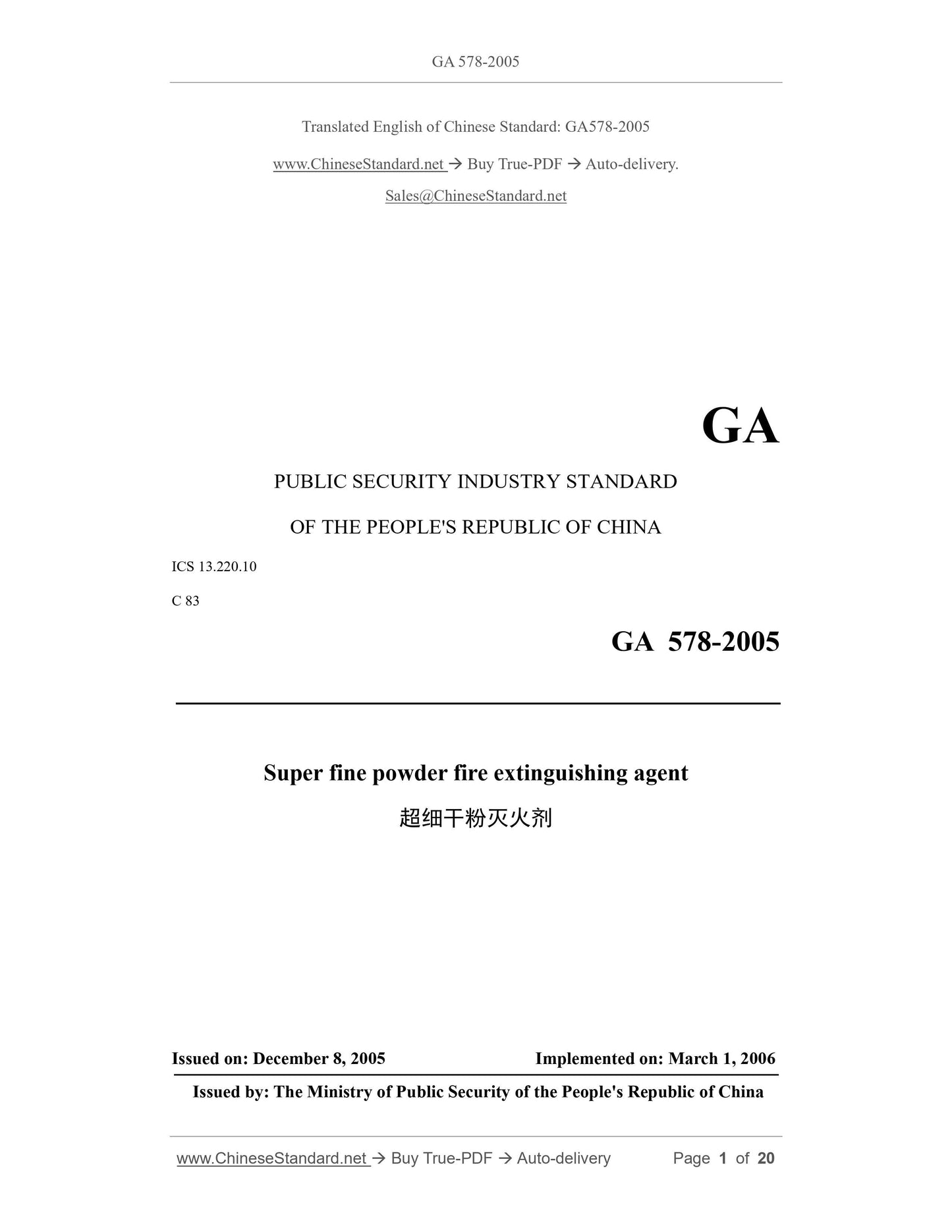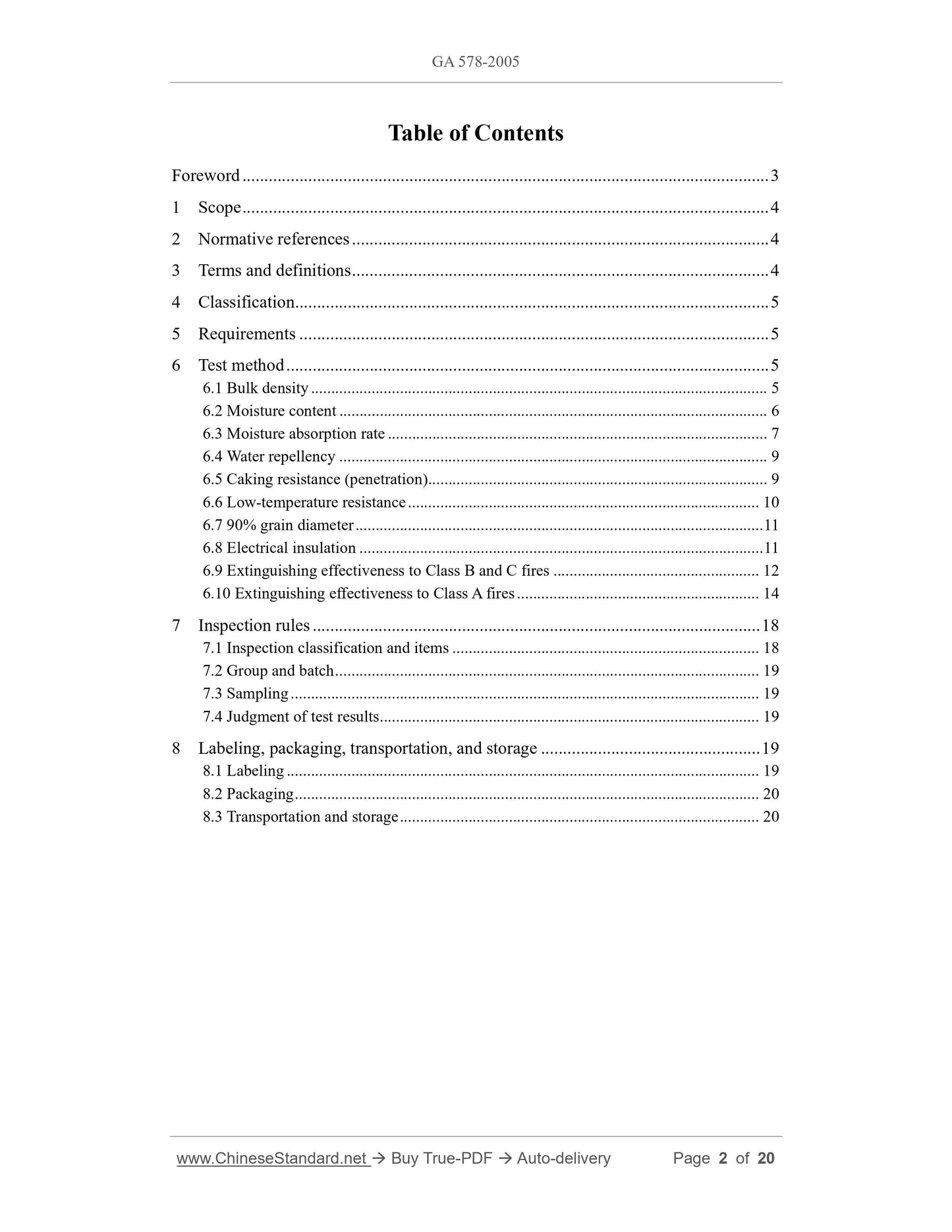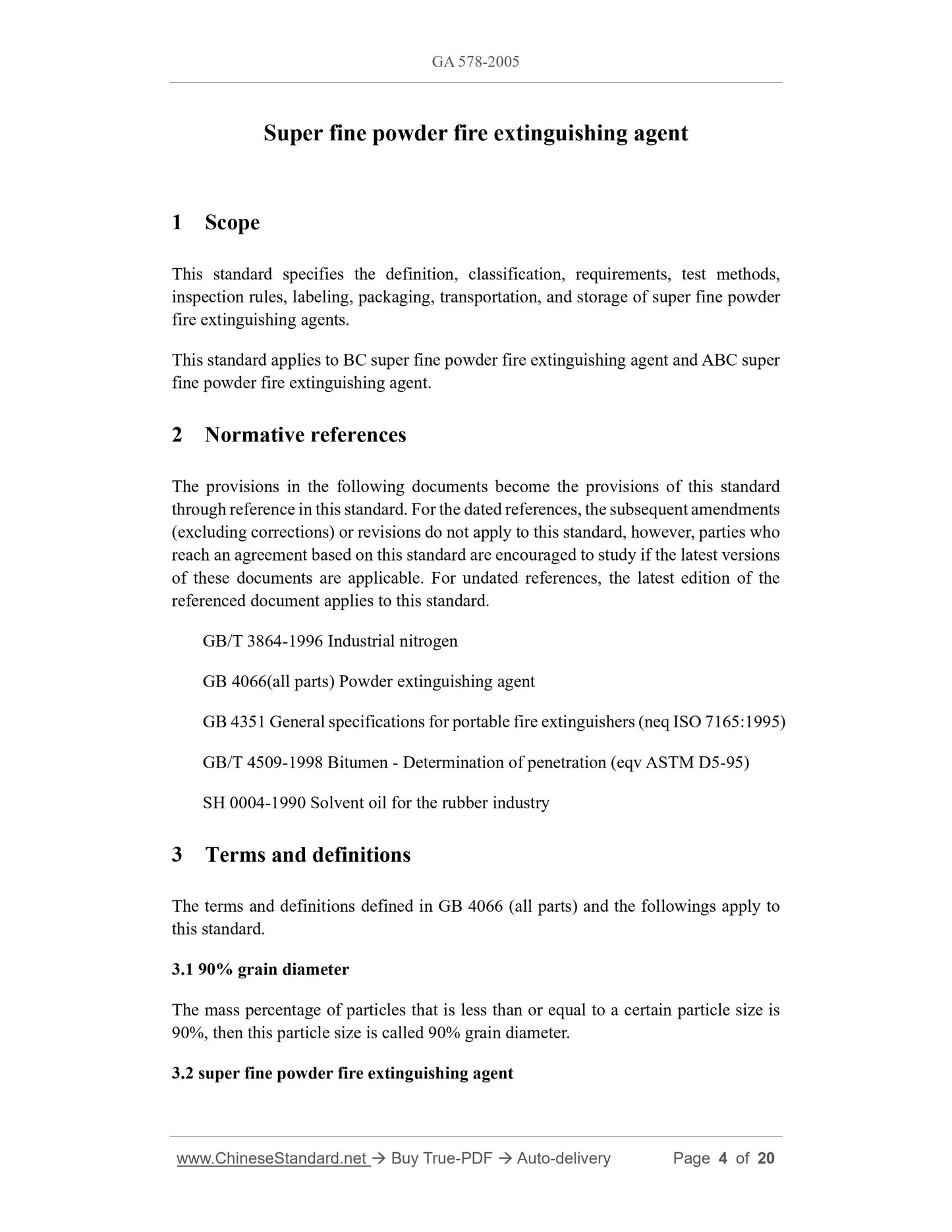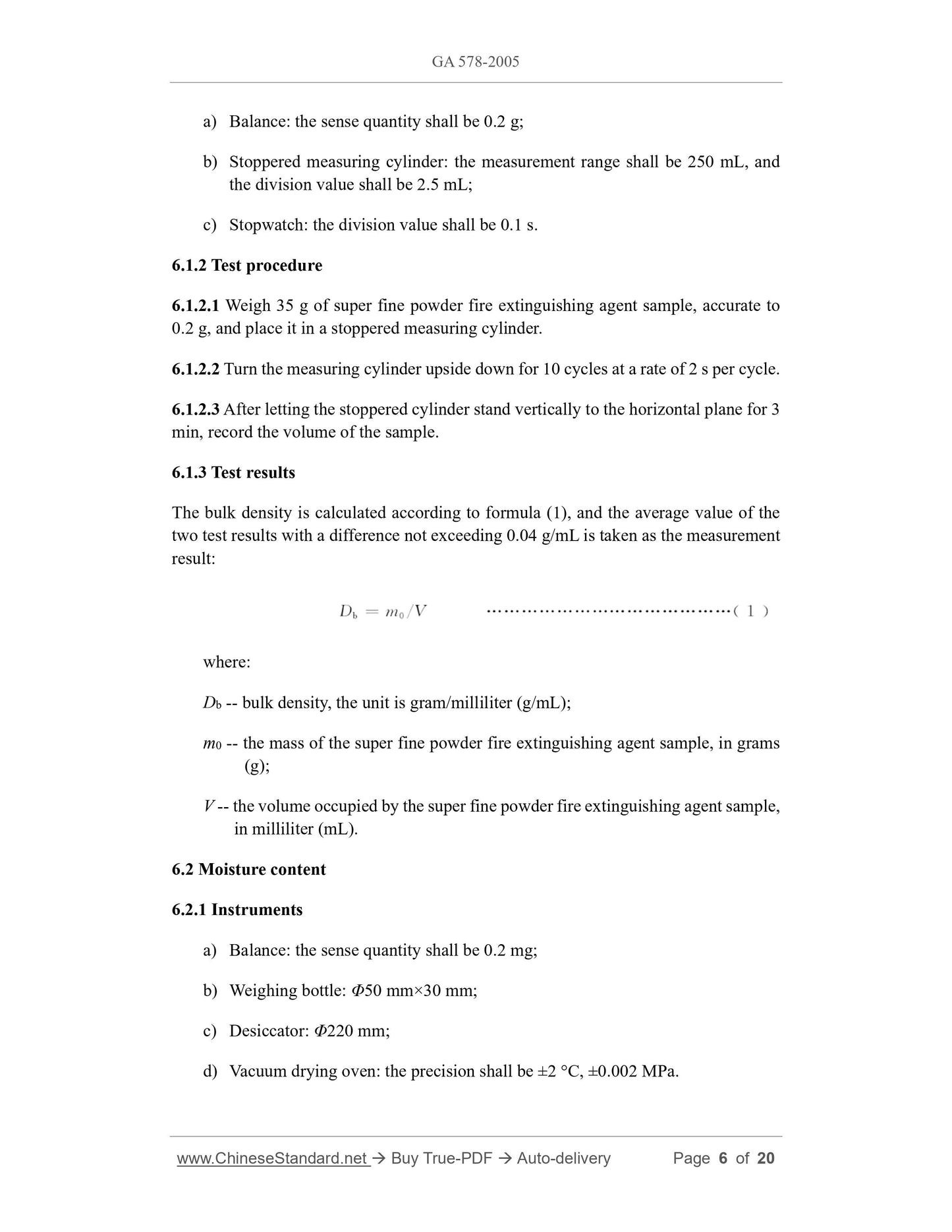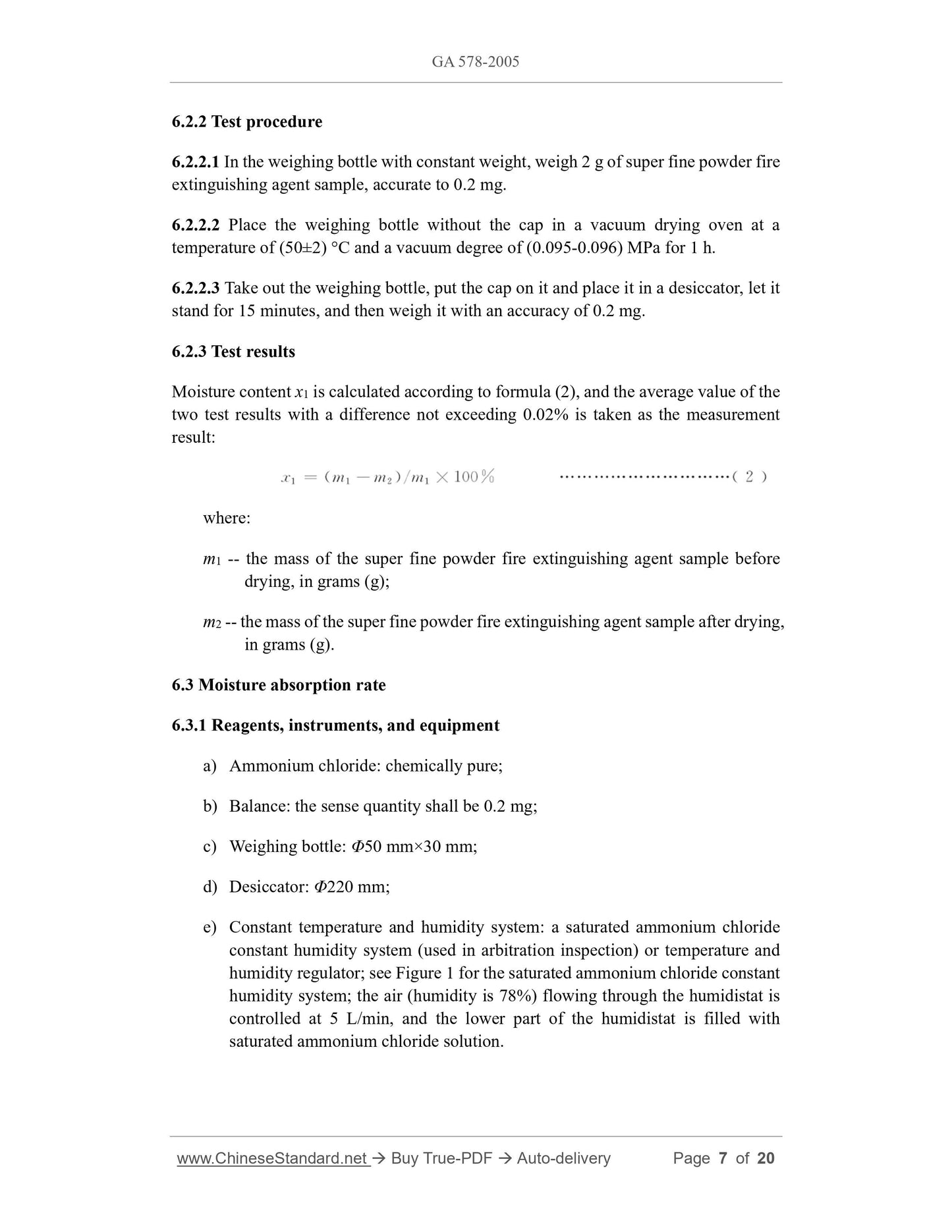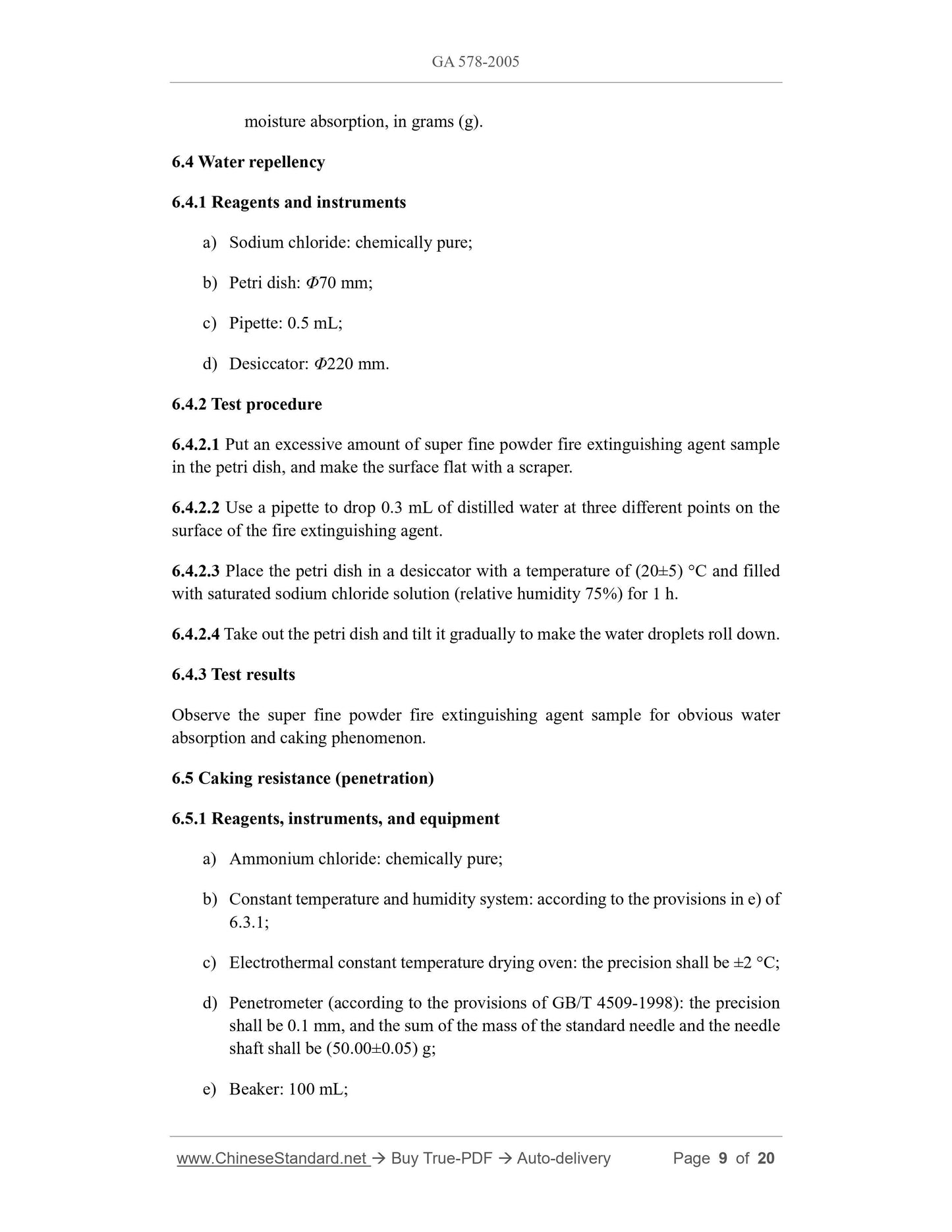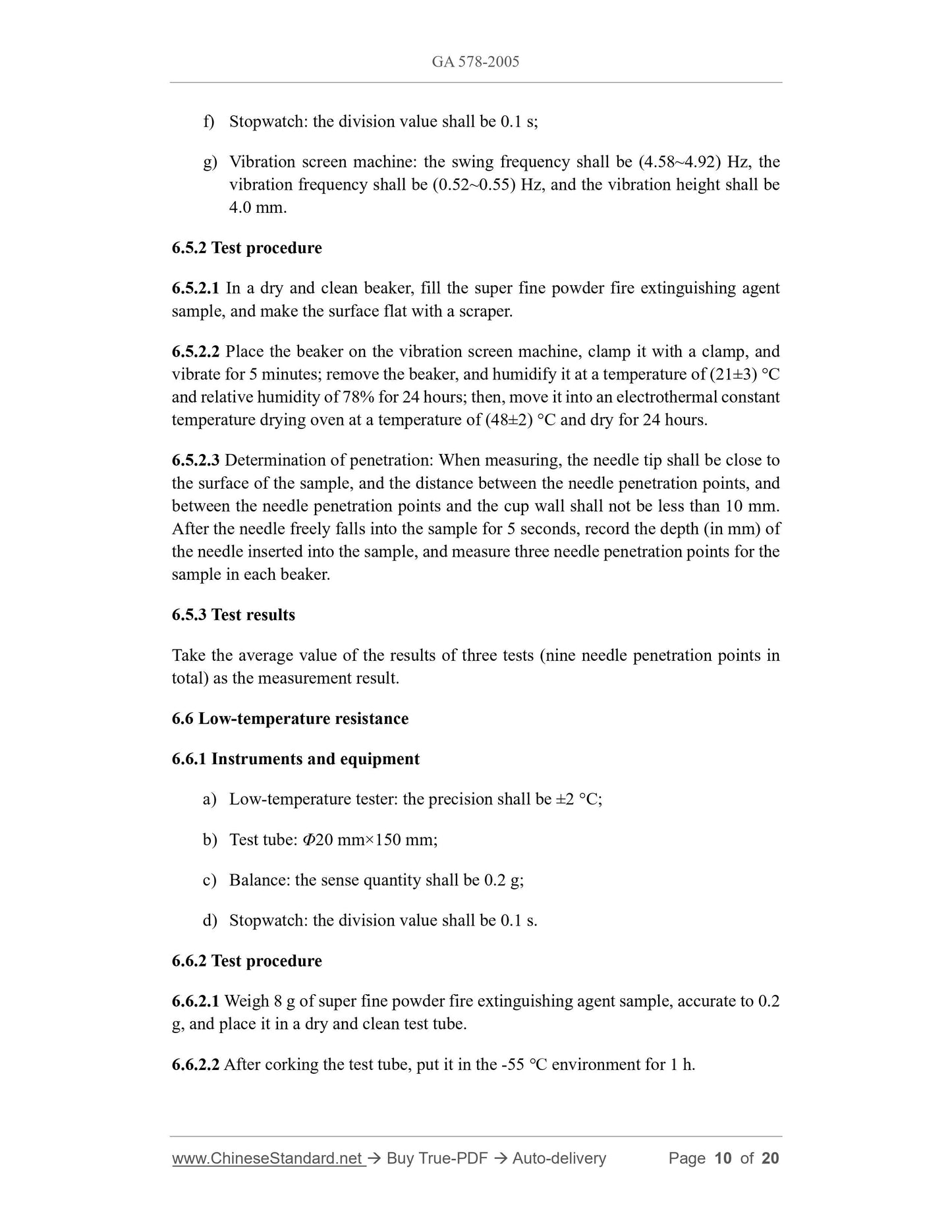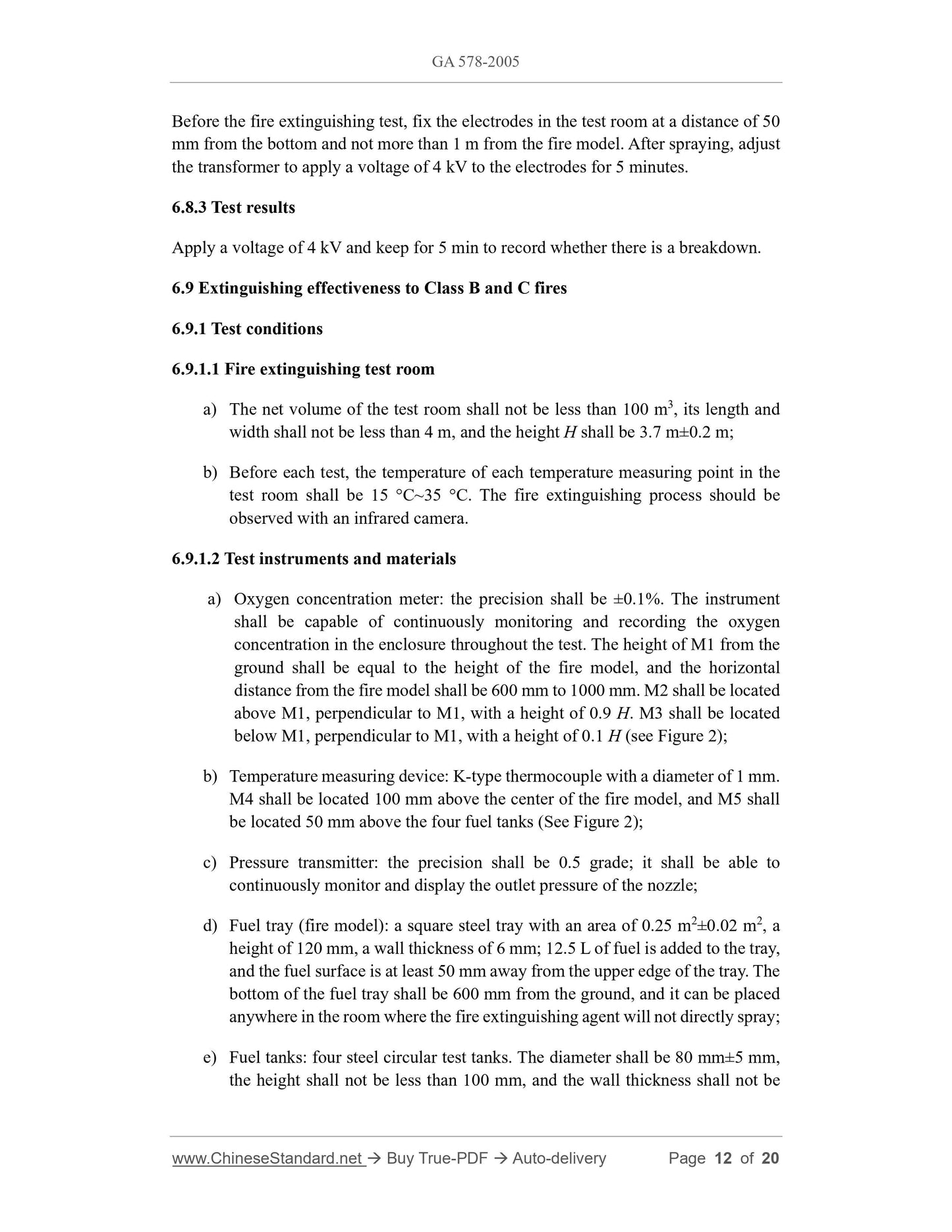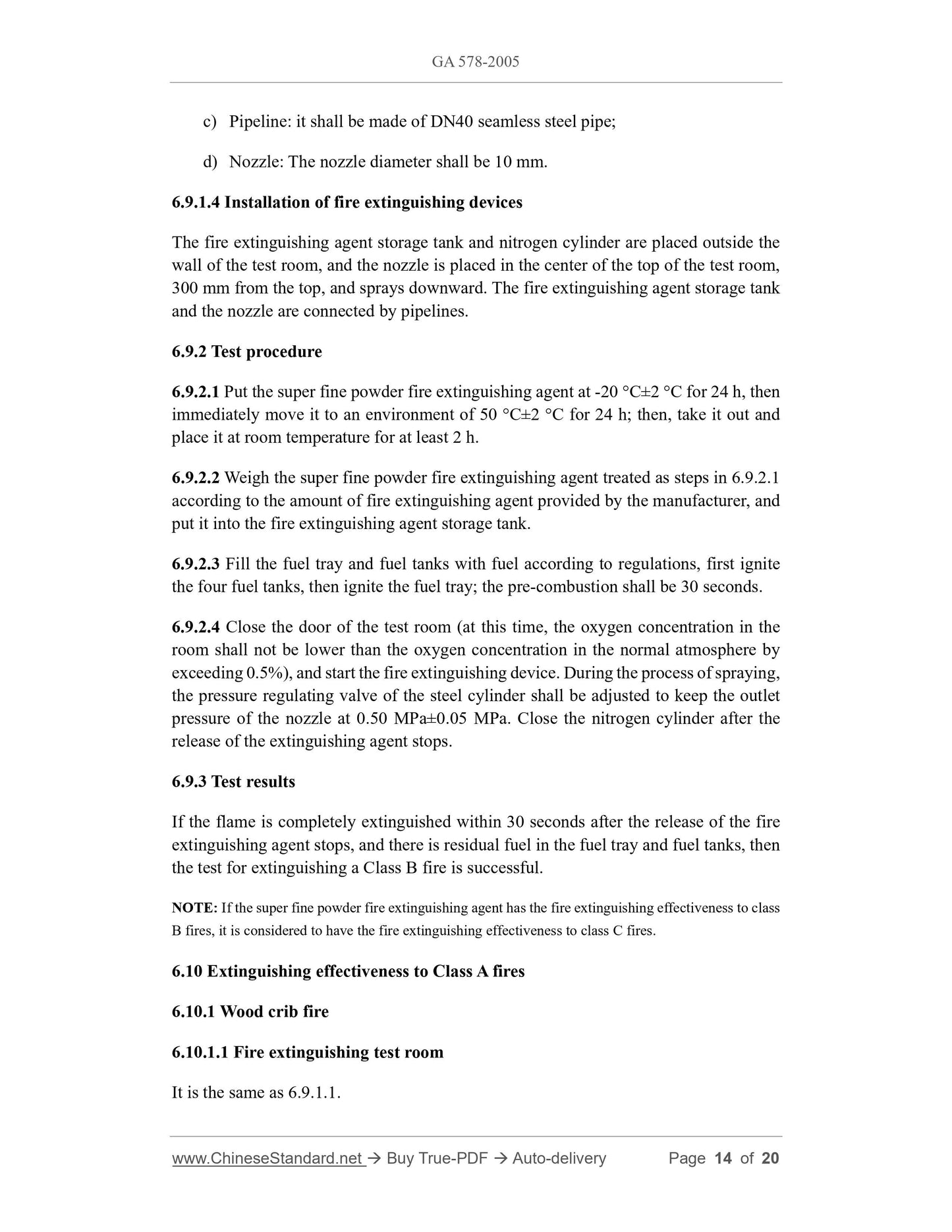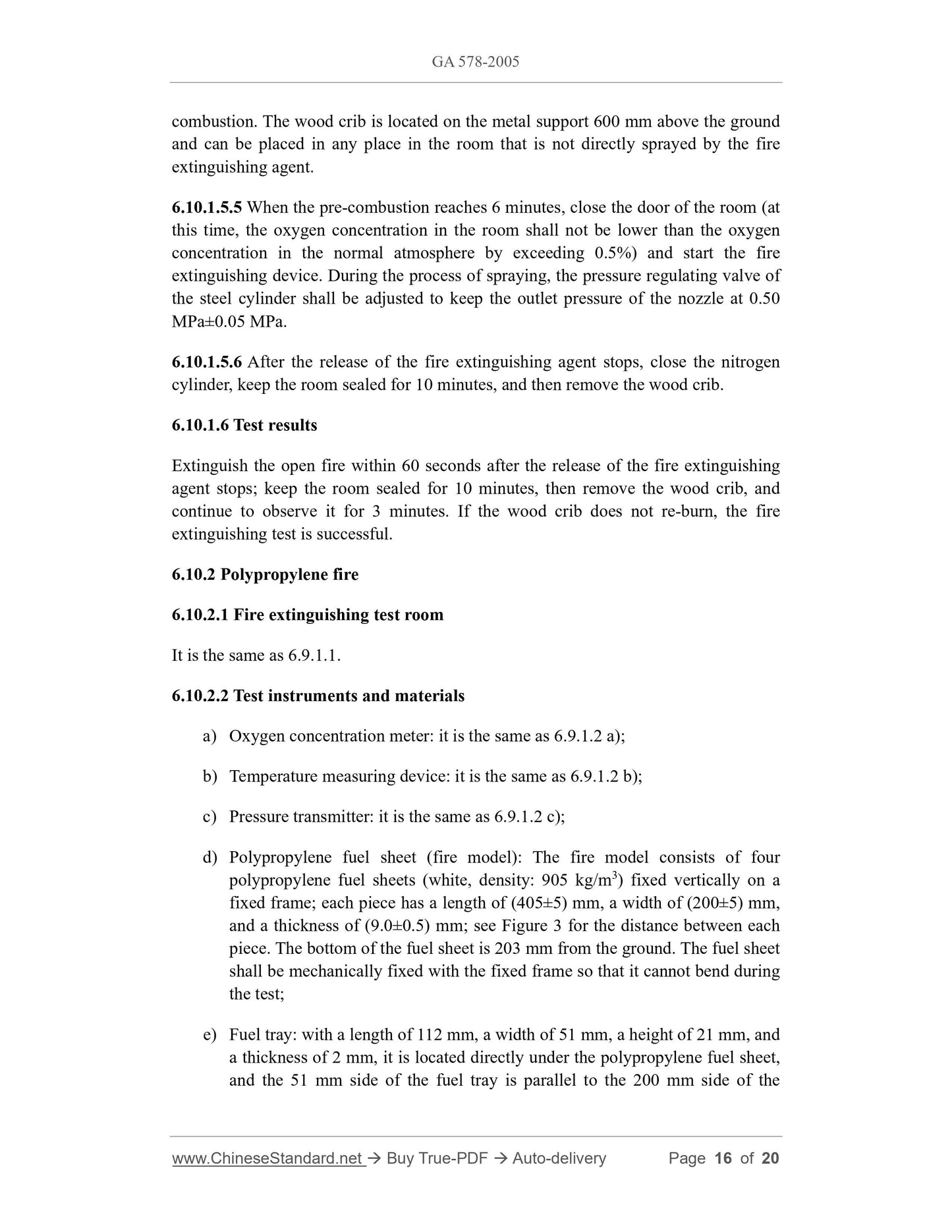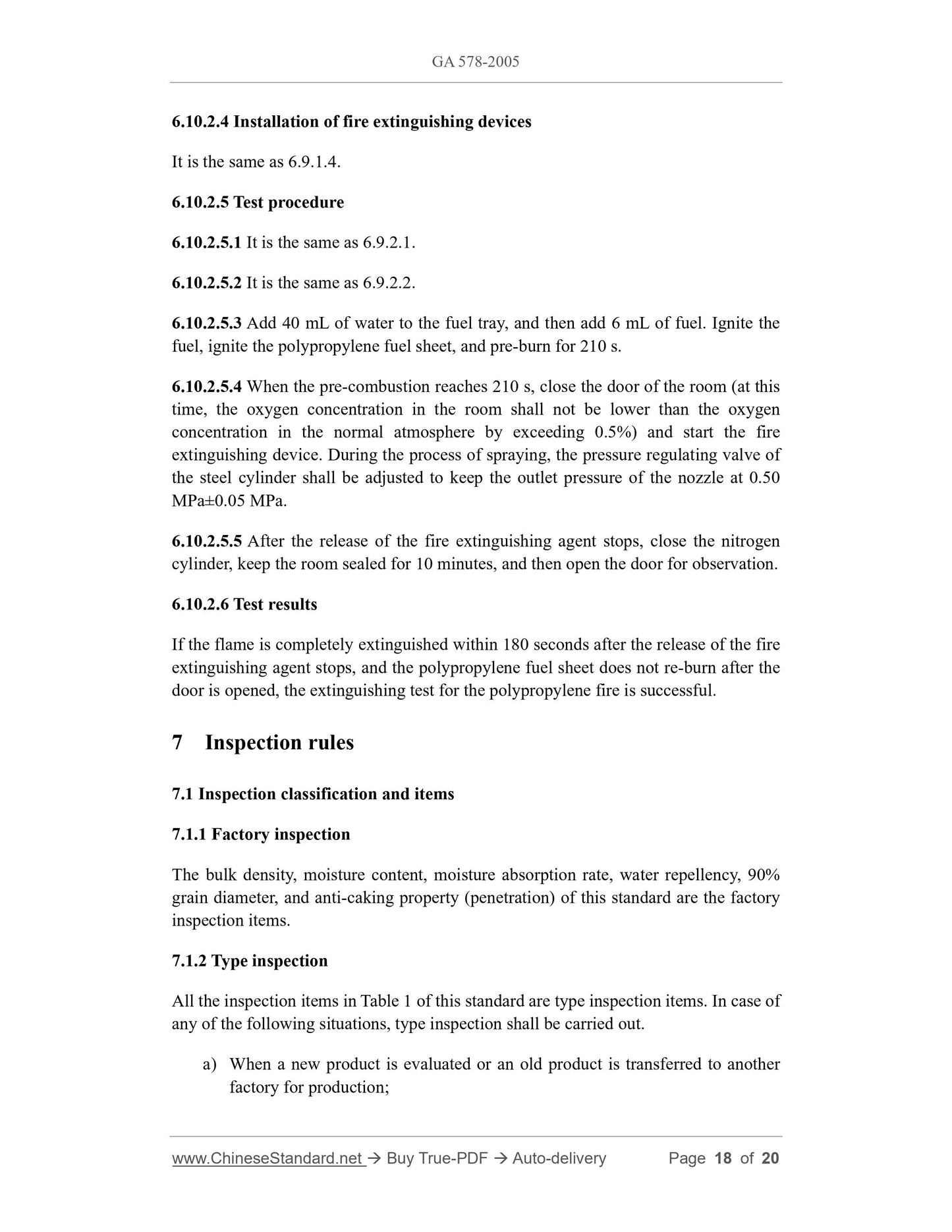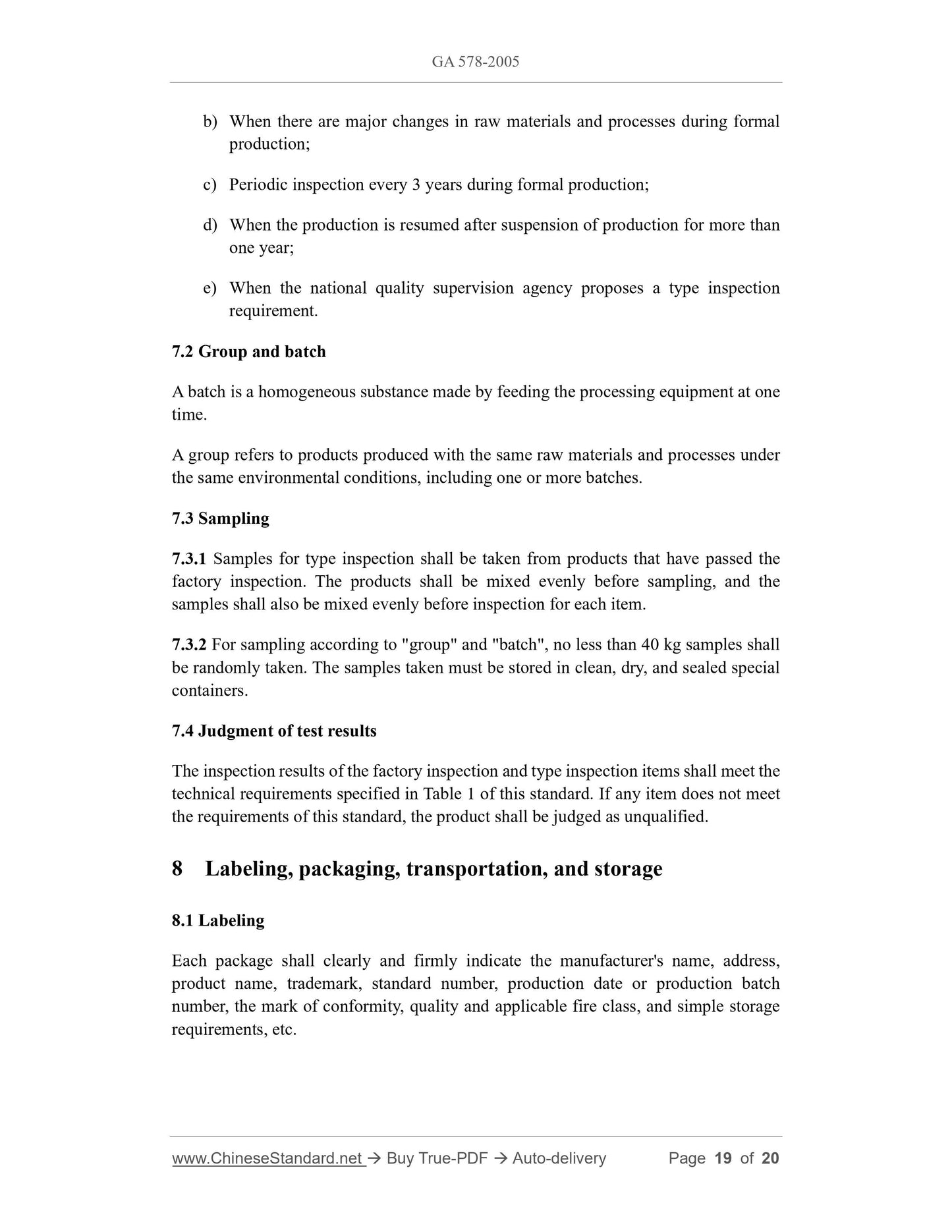1
/
su
12
PayPal, credit cards. Download editable-PDF and invoice in 1 second!
GA 578-2005 English PDF (GA578-2005)
GA 578-2005 English PDF (GA578-2005)
Prezzo di listino
$160.00 USD
Prezzo di listino
Prezzo scontato
$160.00 USD
Prezzo unitario
/
per
Spese di spedizione calcolate al check-out.
Impossibile caricare la disponibilità di ritiro
Delivery: 3 seconds. Download true-PDF + Invoice.
Get QUOTATION in 1-minute: Click GA 578-2005
Historical versions: GA 578-2005
Preview True-PDF (Reload/Scroll if blank)
GA 578-2005: Super fine powder fire extinguishing agent
GA 578-2005
GA
PUBLIC SECURITY INDUSTRY STANDARD
OF THE PEOPLE'S REPUBLIC OF CHINA
ICS 13.220.10
C 83
Super fine powder fire extinguishing agent
超细干粉灭火剂
ISSUED ON: DECEMBER 8, 2005
IMPLEMENTED ON: MARCH 1, 2006
Issued by: The Ministry of Public Security of the People's Republic of China
Table of Contents
Foreword ... 3
1 Scope ... 4
2 Normative references ... 4
3 Terms and definitions ... 4
4 Classification ... 5
5 Requirements ... 5
6 Test method ... 5
6.1 Bulk density ... 5
6.2 Moisture content ... 6
6.3 Moisture absorption rate ... 7
6.4 Water repellency ... 9
6.5 Caking resistance (penetration) ... 9
6.6 Low-temperature resistance ... 10
6.7 90% grain diameter ... 11
6.8 Electrical insulation ... 11
6.9 Extinguishing effectiveness to Class B and C fires ... 12
6.10 Extinguishing effectiveness to Class A fires ... 14
7 Inspection rules ... 18
7.1 Inspection classification and items ... 18
7.2 Group and batch ... 19
7.3 Sampling ... 19
7.4 Judgment of test results ... 19
8 Labeling, packaging, transportation, and storage ... 19
8.1 Labeling ... 19
8.2 Packaging ... 20
8.3 Transportation and storage ... 20
Super fine powder fire extinguishing agent
1 Scope
This standard specifies the definition, classification, requirements, test methods,
inspection rules, labeling, packaging, transportation, and storage of super fine powder
fire extinguishing agents.
This standard applies to BC super fine powder fire extinguishing agent and ABC super
fine powder fire extinguishing agent.
2 Normative references
The provisions in the following documents become the provisions of this standard
through reference in this standard. For the dated references, the subsequent amendments
(excluding corrections) or revisions do not apply to this standard, however, parties who
reach an agreement based on this standard are encouraged to study if the latest versions
of these documents are applicable. For undated references, the latest edition of the
referenced document applies to this standard.
GB/T 3864-1996 Industrial nitrogen
GB 4066(all parts) Powder extinguishing agent
GB 4351 General specifications for portable fire extinguishers (neq ISO 7165:1995)
GB/T 4509-1998 Bitumen - Determination of penetration (eqv ASTM D5-95)
SH 0004-1990 Solvent oil for the rubber industry
3 Terms and definitions
The terms and definitions defined in GB 4066 (all parts) and the followings apply to
this standard.
3.1 90% grain diameter
The mass percentage of particles that is less than or equal to a certain particle size is
90%, then this particle size is called 90% grain diameter.
3.2 super fine powder fire extinguishing agent
a) Balance: the sense quantity shall be 0.2 g;
b) Stoppered measuring cylinder: the measurement range shall be 250 mL, and
the division value shall be 2.5 mL;
c) Stopwatch: the division value shall be 0.1 s.
6.1.2 Test procedure
6.1.2.1 Weigh 35 g of super fine powder fire extinguishing agent sample, accurate to
0.2 g, and place it in a stoppered measuring cylinder.
6.1.2.2 Turn the measuring cylinder upside down for 10 cycles at a rate of 2 s per cycle.
6.1.2.3 After letting the stoppered cylinder stand vertically to the horizontal plane for 3
min, record the volume of the sample.
6.1.3 Test results
The bulk density is calculated according to formula (1), and the average value of the
two test results with a difference not exceeding 0.04 g/mL is taken as the measurement
result:
where:
Db -- bulk density, the unit is gram/milliliter (g/mL);
m0 -- the mass of the super fine powder fire extinguishing agent sample, in grams
(g);
V -- the volume occupied by the super fine powder fire extinguishing agent sample,
in milliliter (mL).
6.2 Moisture content
6.2.1 Instruments
a) Balance: the sense quantity shall be 0.2 mg;
b) Weighing bottle: Φ50 mm×30 mm;
c) Desiccator: Φ220 mm;
d) Vacuum drying oven: the precision shall be ±2 °C, ±0.002 MPa.
6.2.2 Test procedure
6.2.2.1 In the weighing bottle with constant weight, weigh 2 g of super fine powder fire
extinguishing agent sample, accurate to 0.2 mg.
6.2.2.2 Place the weighing bottle without the cap in a vacuum drying oven at a
temperature of (50±2) °C and a vacuum degree of (0.095-0.096) MPa for 1 h.
6.2.2.3 Take out the weighing bottle, put the cap on it and place it in a desiccator, let it
stand for 15 minutes, and then weigh it with an accuracy of 0.2 mg.
6.2.3 Test results
Moisture content x1 is calculated according to formula (2), and the average value of the
two test results with a difference not exceeding 0.02% is taken as the measurement
result:
where:
m1 -- the mass of the super fine powder fire extinguishing agent sample before
drying, in grams (g);
m2 -- the mass of the super fine powder fire extinguishing agent sample after drying,
in grams (g).
6.3 Moisture absorption rate
6.3.1 Reagents, instruments, and equipment
a) Ammonium chloride: chemically pure;
b) Balance: the sense quantity shall be 0.2 mg;
c) Weighing bottle: Φ50 mm×30 mm;
d) Desiccator: Φ220 mm;
e) Constant temperature and humidity system: a saturated ammonium chloride
constant humidity system (used in arbitration inspection) or temperature and
humidity regulator; see Figure 1 for the saturated ammonium chloride constant
humidity system; the air (humidity is 78%) flowing through the humidistat is
controlled at 5 L/min, and the lower part of the humidistat is filled with
saturated ammonium chloride solution.
moisture absorption, in grams (g).
6.4 Water repellency
6.4.1 Reagents and instruments
a) Sodium chloride: chemically pure;
b) Petri dish: Φ70 mm;
c) Pipette: 0.5 mL;
d) Desiccator: Φ220 mm.
6.4.2 Test procedure
6.4.2.1 Put an excessive amount of super fine powder fire extinguishing agent sample
in the petri dish, and make the surface flat with a scraper.
6.4.2.2 Use a pipette to drop 0.3 mL of distilled water at three different points on the
surface of the fire extinguishing agent.
6.4.2.3 Place the petri dish in a desiccator with a temperature of (20±5) °C and filled
with saturated sodium chloride solution (relative humidity 75%) for 1 h.
6.4.2.4 Take out the petri dish and tilt it gradually to make the water droplets roll down.
6.4.3 Test results
Observe the super fine powder fire extinguishing agent sample for obvious water
absorption and caking phenomenon.
6.5 Caking resistance (penetration)
6.5.1 Reagents, instruments, and equipment
a) Ammonium chloride: chemically pure;
b) Constant temperature and humidity system: according to the provisions in e) of
6.3.1;
c) Electrothermal constant temperature drying oven: the precision shall be ±2 °C;
d) Penetrometer (according to the provisions of GB/T 4509-1998): the precision
shall be 0.1 mm, and the sum of the mass of the standard needle and the needle
shaft shall be (50.00±0.05) g;
e) Beaker: 100 mL;
f) Stopwatch: the division value shall be 0.1 s;
g) Vibration screen machine: the swing frequency shall be (4.58~4.92) Hz, the
vibration frequency shall be (0.52~0.55) Hz, and the vibration height shall be
4.0 mm.
6.5.2 Test procedure
6.5.2.1 In a dry and clean beaker, fill the super fine powder fire extinguishing agent
sample, and make the surface flat with a scraper.
6.5.2.2 Place the beaker on the vibration screen machine, clamp it with a clamp, and
vibrate...
Get QUOTATION in 1-minute: Click GA 578-2005
Historical versions: GA 578-2005
Preview True-PDF (Reload/Scroll if blank)
GA 578-2005: Super fine powder fire extinguishing agent
GA 578-2005
GA
PUBLIC SECURITY INDUSTRY STANDARD
OF THE PEOPLE'S REPUBLIC OF CHINA
ICS 13.220.10
C 83
Super fine powder fire extinguishing agent
超细干粉灭火剂
ISSUED ON: DECEMBER 8, 2005
IMPLEMENTED ON: MARCH 1, 2006
Issued by: The Ministry of Public Security of the People's Republic of China
Table of Contents
Foreword ... 3
1 Scope ... 4
2 Normative references ... 4
3 Terms and definitions ... 4
4 Classification ... 5
5 Requirements ... 5
6 Test method ... 5
6.1 Bulk density ... 5
6.2 Moisture content ... 6
6.3 Moisture absorption rate ... 7
6.4 Water repellency ... 9
6.5 Caking resistance (penetration) ... 9
6.6 Low-temperature resistance ... 10
6.7 90% grain diameter ... 11
6.8 Electrical insulation ... 11
6.9 Extinguishing effectiveness to Class B and C fires ... 12
6.10 Extinguishing effectiveness to Class A fires ... 14
7 Inspection rules ... 18
7.1 Inspection classification and items ... 18
7.2 Group and batch ... 19
7.3 Sampling ... 19
7.4 Judgment of test results ... 19
8 Labeling, packaging, transportation, and storage ... 19
8.1 Labeling ... 19
8.2 Packaging ... 20
8.3 Transportation and storage ... 20
Super fine powder fire extinguishing agent
1 Scope
This standard specifies the definition, classification, requirements, test methods,
inspection rules, labeling, packaging, transportation, and storage of super fine powder
fire extinguishing agents.
This standard applies to BC super fine powder fire extinguishing agent and ABC super
fine powder fire extinguishing agent.
2 Normative references
The provisions in the following documents become the provisions of this standard
through reference in this standard. For the dated references, the subsequent amendments
(excluding corrections) or revisions do not apply to this standard, however, parties who
reach an agreement based on this standard are encouraged to study if the latest versions
of these documents are applicable. For undated references, the latest edition of the
referenced document applies to this standard.
GB/T 3864-1996 Industrial nitrogen
GB 4066(all parts) Powder extinguishing agent
GB 4351 General specifications for portable fire extinguishers (neq ISO 7165:1995)
GB/T 4509-1998 Bitumen - Determination of penetration (eqv ASTM D5-95)
SH 0004-1990 Solvent oil for the rubber industry
3 Terms and definitions
The terms and definitions defined in GB 4066 (all parts) and the followings apply to
this standard.
3.1 90% grain diameter
The mass percentage of particles that is less than or equal to a certain particle size is
90%, then this particle size is called 90% grain diameter.
3.2 super fine powder fire extinguishing agent
a) Balance: the sense quantity shall be 0.2 g;
b) Stoppered measuring cylinder: the measurement range shall be 250 mL, and
the division value shall be 2.5 mL;
c) Stopwatch: the division value shall be 0.1 s.
6.1.2 Test procedure
6.1.2.1 Weigh 35 g of super fine powder fire extinguishing agent sample, accurate to
0.2 g, and place it in a stoppered measuring cylinder.
6.1.2.2 Turn the measuring cylinder upside down for 10 cycles at a rate of 2 s per cycle.
6.1.2.3 After letting the stoppered cylinder stand vertically to the horizontal plane for 3
min, record the volume of the sample.
6.1.3 Test results
The bulk density is calculated according to formula (1), and the average value of the
two test results with a difference not exceeding 0.04 g/mL is taken as the measurement
result:
where:
Db -- bulk density, the unit is gram/milliliter (g/mL);
m0 -- the mass of the super fine powder fire extinguishing agent sample, in grams
(g);
V -- the volume occupied by the super fine powder fire extinguishing agent sample,
in milliliter (mL).
6.2 Moisture content
6.2.1 Instruments
a) Balance: the sense quantity shall be 0.2 mg;
b) Weighing bottle: Φ50 mm×30 mm;
c) Desiccator: Φ220 mm;
d) Vacuum drying oven: the precision shall be ±2 °C, ±0.002 MPa.
6.2.2 Test procedure
6.2.2.1 In the weighing bottle with constant weight, weigh 2 g of super fine powder fire
extinguishing agent sample, accurate to 0.2 mg.
6.2.2.2 Place the weighing bottle without the cap in a vacuum drying oven at a
temperature of (50±2) °C and a vacuum degree of (0.095-0.096) MPa for 1 h.
6.2.2.3 Take out the weighing bottle, put the cap on it and place it in a desiccator, let it
stand for 15 minutes, and then weigh it with an accuracy of 0.2 mg.
6.2.3 Test results
Moisture content x1 is calculated according to formula (2), and the average value of the
two test results with a difference not exceeding 0.02% is taken as the measurement
result:
where:
m1 -- the mass of the super fine powder fire extinguishing agent sample before
drying, in grams (g);
m2 -- the mass of the super fine powder fire extinguishing agent sample after drying,
in grams (g).
6.3 Moisture absorption rate
6.3.1 Reagents, instruments, and equipment
a) Ammonium chloride: chemically pure;
b) Balance: the sense quantity shall be 0.2 mg;
c) Weighing bottle: Φ50 mm×30 mm;
d) Desiccator: Φ220 mm;
e) Constant temperature and humidity system: a saturated ammonium chloride
constant humidity system (used in arbitration inspection) or temperature and
humidity regulator; see Figure 1 for the saturated ammonium chloride constant
humidity system; the air (humidity is 78%) flowing through the humidistat is
controlled at 5 L/min, and the lower part of the humidistat is filled with
saturated ammonium chloride solution.
moisture absorption, in grams (g).
6.4 Water repellency
6.4.1 Reagents and instruments
a) Sodium chloride: chemically pure;
b) Petri dish: Φ70 mm;
c) Pipette: 0.5 mL;
d) Desiccator: Φ220 mm.
6.4.2 Test procedure
6.4.2.1 Put an excessive amount of super fine powder fire extinguishing agent sample
in the petri dish, and make the surface flat with a scraper.
6.4.2.2 Use a pipette to drop 0.3 mL of distilled water at three different points on the
surface of the fire extinguishing agent.
6.4.2.3 Place the petri dish in a desiccator with a temperature of (20±5) °C and filled
with saturated sodium chloride solution (relative humidity 75%) for 1 h.
6.4.2.4 Take out the petri dish and tilt it gradually to make the water droplets roll down.
6.4.3 Test results
Observe the super fine powder fire extinguishing agent sample for obvious water
absorption and caking phenomenon.
6.5 Caking resistance (penetration)
6.5.1 Reagents, instruments, and equipment
a) Ammonium chloride: chemically pure;
b) Constant temperature and humidity system: according to the provisions in e) of
6.3.1;
c) Electrothermal constant temperature drying oven: the precision shall be ±2 °C;
d) Penetrometer (according to the provisions of GB/T 4509-1998): the precision
shall be 0.1 mm, and the sum of the mass of the standard needle and the needle
shaft shall be (50.00±0.05) g;
e) Beaker: 100 mL;
f) Stopwatch: the division value shall be 0.1 s;
g) Vibration screen machine: the swing frequency shall be (4.58~4.92) Hz, the
vibration frequency shall be (0.52~0.55) Hz, and the vibration height shall be
4.0 mm.
6.5.2 Test procedure
6.5.2.1 In a dry and clean beaker, fill the super fine powder fire extinguishing agent
sample, and make the surface flat with a scraper.
6.5.2.2 Place the beaker on the vibration screen machine, clamp it with a clamp, and
vibrate...
Share
